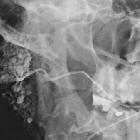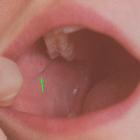foramen tympanicum
The foramen tympanicum (plural: foramina tympanica), also known as foramen of Huschke, is an anatomical variation in the external acoustic canal (EAC), where a bony defect connects the EAC to the temporomandibular joint (TMJ).
Epidemiology
Various studies have reported on the occurrence of a foramen tympanicum in the asymptomatic population, with a reported prevalence of 4.6-20%.
Clinical presentation
Most cases are asymptomatic, but a patent foramen tympanicum has been reported as being the cause of persistent ear discharge following mastication due to the connection with the TMJ or fistula with the parotid gland . During TMJ arthroscopy, the foramen tympanicum may lead to inadvertent passage of the endoscope into the TMJ, with resulting damage . Spread of infection between the EAC and infratemporal fossa can also occur through this anatomical variation .
Gross anatomy
Development
The external ear canal is incompletely formed at birth, and further post-natal development results in two prominences (anterior and posterior) growing towards each other to form the EAC inferiorly. Lack of fusion of the anterior and posterior prominences with each other results in a persistent gap, the foramen tympanicum . Of note, the foramen tympanicum can close at up to 5 years of age, and hence it should only be diagnosed after this age .
Radiographic features
CT
High resolution CT of the petrous temporal bone is the imaging study of choice. The foramen tympanicum arises in the antero-inferior part of the EAC, and is postero-medial to the TMJ. The opposite side should be examined with care, as bilateral cases have been reported in 6% .
Treatment and prognosis
The foramen tympanicum is an incidental finding in most cases and does not need treatment in these cases. However, its presence should be sought if a patient presents with persistent ear discharge. Surgical treatment to obliterate the space between the EAC and TMJ is usually successful , and any other unusual specific pathology can be addressed at the time, e.g. parotid duct fistula, or herniation of TMJ synovium .
Differential diagnosis
External auditory cholesteatoma has to be excluded.
History and etymology
It was first described by Emil Huschke (1797-1858): German anatomist and embryologist.
Siehe auch:

 Assoziationen und Differentialdiagnosen zu foramen tympanicum:
Assoziationen und Differentialdiagnosen zu foramen tympanicum:


